Abstract
Quantum locking using optical spring and homodyne detection has been devised to reduce the quantum noise that limits the sensitivity of the DECIGO, a space-based gravitational-wave antenna in the frequency band around 0.1 Hz for the detection of primordial gravitational waves. The reduction in the upper limit of energy density from to , as inferred from recent observations, necessitates improved sensitivity in the DECIGO to meet its primary science goals. To accurately evaluate the effectiveness of this method, this paper considers a detection mechanism that takes into account the influence of vacuum fluctuations on homodyne detection. In addition, an advanced signal processing method is devised to efficiently utilize signals from each photodetector, and design parameters for this configuration are optimized for the quantum noise. Our results show that this method is effective in reducing quantum noise, despite the detrimental impact of vacuum fluctuations on its sensitivity.
1. Introduction
Since the first detection of gravitational waves in 2015 [1], the ongoing observation of gravitational waves resulting from the mergers of binary black holes and binary neutron stars has marked a momentous juncture in the domain of gravitational-wave astronomy. This continuous endeavor bestows upon us novel perspectives into astronomical phenomena, catalyzing a revolutionary transformation within the field of astronomy [2]. Moreover, it is envisaged that the growing significance of gravitational-wave detections will play an increasingly pivotal role in the realm of astronomy, with contributions from ground-based detectors such as Einstein Telescope [3] and Cosimic Explorer [4] or space-based detectors such as LISA [5]. This is owing to their unique ability to discern enigmatic phenomena that pose formidable challenges for observation through electromagnetic waves.
The focus of our research is primordial gravitational waves. If we can directly detect these gravitational waves, which originate from quantum fluctuations in spacetime during cosmic inflation, we can gain a more detailed understanding of the early stages of the universe, including confirming the occurrence of cosmic inflation [6]. Detectors exhibiting high sensitivity in the frequency band around 0.1 Hz, which are free of seismic noise from the earth and thermal noise from mirror suspension, are required. However, the conventional ground-based detectors, LIGO [7], VIRGO [8] and KAGRA [9], cannot remove them.
Our project for these detections is called the DECi-hertz Interferometer Gravitational-wave Observatory (DECIGO) and has been promoted as a space-based gravitational-wave antenna in Japan [10,11]. The DECIGO stands out due to its distinctive utilization of three drag-free satellites deployed in space and a Fabry–Perot interferometer configuration, spanning a length of 1000 km, to mitigate the adverse effects of Earth’s seismic noise and thermal noise from mirror suspensions. This configuration therefore allows us to target a lower-frequency band (in this case, the 0.1 Hz band) than the frequency band where ground-based detectors have high sensitivity, typically around 100 Hz. Meanwhile, recent analyses of observations by the Planck satellite and others [12] have shown that the original design of the DECIGO was not sensitive enough to detect primordial gravitational waves. Hence, developing techniques to improve the sensitivity of DECIGO is required. Previous studies have proposed optimizing the design parameters of the DECIGO [13,14,15], as well as a technique known as quantum locking [16,17], to enhance sensitivity by mitigating quantum noise. Quantum noise predominantly affects low-frequency bands and arises from the quantum fluctuations of laser light. Notably, quantum locking involves incorporating subcavities on both sides that share a mirror with the 1,000 km primary cavity, resulting in a reduction in radiation pressure noise. Given the high optical loss and lack of squeezing feasibility in the main cavity of the DECIGO, this method proves to be exceptionally effective [18], and its utility has been progressively confirmed through in-principle verification experiments [19]. Additionally, the configuration termed optical-spring quantum locking, which employs optical springs [20] and homodyne detection in subcavities for quantum locking, has theoretically exhibited a considerable enhancement in sensitivity [21].
However, prior investigations have not employed homodyne detection based on an experimental setup that faithfully reflects the actual optical effects, rather assuming ideal homodyne detection. This limitation arises due to the treatment of parameter , which is responsible for determining the direction of homodyne detection, which has not been ascertained through interference light but rather is regarded as an independent variable subject to arbitrary choice during simulations. In order to faithfully model the system based on the actual setup, it becomes imperative to account for the influence of the mixture of vacuum fluctuations. Consequently, the determination of the homodyne detection direction necessitates the extraction of light from the conventional optical path to produce interference, wherein the use of beam splitters, acting as points of interference, is indispensable. Hence, the primary objective of this paper is the accurate evaluation of the homodyne detection approach, taking into consideration the mixture of vacuum fluctuations. Furthermore, in this configuration, an additional photodetector can be employed, and we propose a method to utilize the signal from this supplementary photodetector. In this paper, we apply this method, while optimizing each design parameter in a manner akin to previous research [21].
In Section 2, a more elaborate elucidation of the optical design is presented, encompassing the mitigation of quantum noise through optical-spring quantum locking, along with the configuration of homodyne detection incorporating these constituents. This intricate approach to signal optimization, achieved through the combination of multiple signals, is expounded upon in Section 3. Furthermore, this section offers a comprehensive block diagram illustrating the acquisition of these signals. Section 4 through Section 5 showcase simulation results, demonstrating the parameters that yield the utmost sensitivity for the DECIGO under this configuration, as well as the corresponding obtained signals. Additionally, we delve into the sensitivity difference in the DECIGO in comparison with prior research.
2. Optical Design
2.1. Optical-Spring Quantum Locking
In this subsection, we describe the optical-spring quantum locking used to reduce quantum noise. Initially, we elucidate the methodology employed to address quantum fluctuations, utilizing a mathematical framework known as quadrature-phase amplitude [22]. This formalism incorporates the application of creation and annihilation operators, denoted as and , respectively, which satisfy the commutation relation (Equation (1)). These operators play a pivotal role in the analysis of the optical mode within each cavity.
Here, j is an identifier of the three cavities, indicating Main (=m), Sub1 (=s1) or Sub2 (=s2). Then, using and operators, the amplitude quantum fluctuation and phase quantum fluctuation are defined by
We now elaborate on the approach of reducing quantum noise through quantum locking. Figure 1 illustrates the standard configuration of quantum locking designed for the DECIGO. In this configuration, supplementary subcavities, equipped with shorter cavity lengths and shared mirrors, are appended to both sides of the main optical cavity, which spans a distance of 1000 km between the DECIGO satellites. Notably, the laser sources employed for the subcavities differ from the ones utilized for the main cavity. Based on this setup, crucial information concerning the amplitude quantum fluctuations of the main laser light can be extracted from the signals transmitted via the subcavity laser light. By regulating the shared mirror using these signals, it becomes possible to effectively nullify the radiation pressure noise stemming from the main cavity, while simultaneously preserving the underlying gravitational-wave signal.
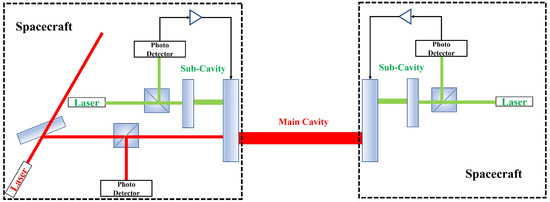
Figure 1.
Standard configuration of quantum locking in the DECIGO. The path that the red laser light passes through represents the main cavity, while the paths that the green laser lights pass through correspond to the subcavities. The two mirrors of the main cavity are shared with the subcavities, and the photodetector signals from the subcavities contain information regarding the noise induced by the main laser light.
Moreover, we utilize the optical spring for the subcavities. The optical spring is a contrived technology that accomplishes heightened sensitivity by creating the interaction between mechanical and optical effects [20]. A mirror positioned slightly away from the resonance point experiences a constant external force that counterbalances the radiation force within the cavity. Consequently, when the radiation force changes due to quantum fluctuations, the mirror behaves akin to one mounted on a spring due to its relationship with the radiation force.
2.2. Homodyne Detection
In addition to employing optical-spring quantum locking, we adopt homodyne detection to mitigate the influence of quantum noise. The concept of homodyne detection is elucidated in Figure 2. In this configuration, beam splitter 1 (=BS1) is strategically positioned to extract light as a local oscillator from the incident light directed towards the cavity. Meanwhile, beam splitter 2 (=BS2) brings the local oscillator light to interference with the light that either reflects or traverses the cavity. This arrangement allows for detection along a direction different from that of the normal carrier light, playing a crucial role in quantum noise reduction. The interfered light is subsequently captured by two photodetectors, as depicted in the figure. The variables and , which determine the detection axis angle, are derived through the ensuing steps. To commence, let us delineate the electric field of the light emanating from the laser source as follows:
where is a constant representing the amplitude of the electric field, and is the angular frequency of the laser light. At the same time, the local oscillator is obtained using the amplitude reflectance of BS1, given by
Here, is a parameter defined as the relative phase shift associated with the change in the optical path length. The light directed towards the cavity combines the light entering the cavity with the light reflected by the input mirror, and the carrier light is expressed as follows:
Here, represents the amplitude transmittance of BS1, while and correspond to the amplitude reflectance or the amplitude transmittance of the mirrors used in the subcavities. For the subsequent calculations, we set to 1, and to 0. Furthermore, is defined as the change in laser phase when the laser light completes one round trip through the cavities. Consequently, the field falling on the photodiodes by lights passing through each optical path is given as follows:
Hence, through the consideration of the electric field pertaining to the laser emission at its immediate inception as the point of reference, each instance of interference light is detected along an axis rotated at an angle ascertained by the subsequent equation:
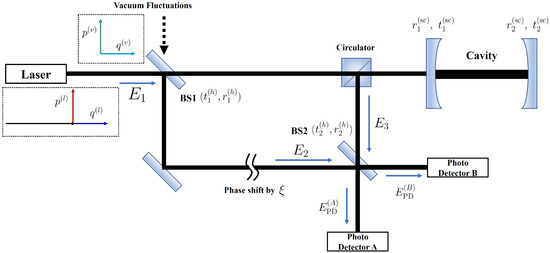
Figure 2.
Concept of homodyne detection: The lower path represents the optical path for the local oscillator, which undergoes a phase shift by . is the classical electric field of the laser light. The regions enclosed by dotted lines are quantum fluctuations of the laser right or vacuum fluctuations. We use superscript to denote quantum fluctuations of the laser light and superscript to denote vacuum fluctuations, distinguishing their respective noise sources.
Next, we consider the quantum state at this juncture. If the quantum state of the laser light manifests as a coherent state, then the light extracted as a local oscillator, influenced solely by the amplitude reflectance of BS1, also assumes a coherent state. On the contrary, the light emanating from the cavity to the BS2 exhibits a squeezed state. This arises due to the amplitude fluctuations of the laser light, which result in mirror displacements and changes in the optical path length, thereby causing amplitude fluctuations to manifest as phase fluctuations. This phenomenon is referred to as ponderomotive squeezing [23]. Consequently, the interference light resulting from the combination of these two beams is squeezed in its quantum state. Thus, quantum noise can be ameliorated by judiciously selecting an appropriate angle for the detection axis, as defined in Equation (8). The optimal angle is determined such that the projective component of the quantum fluctuation along this axis nullifies each other.
Incidentally, it should be noted that this particular configuration embraces vacuum fluctuations at BS1. Omitting the consideration of vacuum fluctuations would lead to a reduction in the quantum fluctuation of the light transmitted or reflected by BS1. Hence, we introduce a symmetrical position with respect to the beam splitter, as illustrated in the figure, wherein vacuum fluctuations are injected. This serves to compensate for the reduction in quantum fluctuation of the laser light.
3. Signal Processing
3.1. Block Diagram
We utilize a block diagram to portray the interferometer configuration shown in Figure 1, which integrates optical-spring quantum locking and accounts for the amalgamation of vacuum fluctuations in homodyne detection, as depicted in Figure 3. This schematic comprises three distinct sections: the upper and lower segments represent the subcavities, while the central segment denotes the main cavity. The purple and yellow regions on the left side correspond to quantum fluctuations of the laser light and the mixed vacuum fluctuations in homodyne detection, respectively. Within these regions, the upper port signifies amplitude quantum fluctuations, whereas the lower port pertains to phase fluctuations. On the right side, the cyan region designates the detection port.
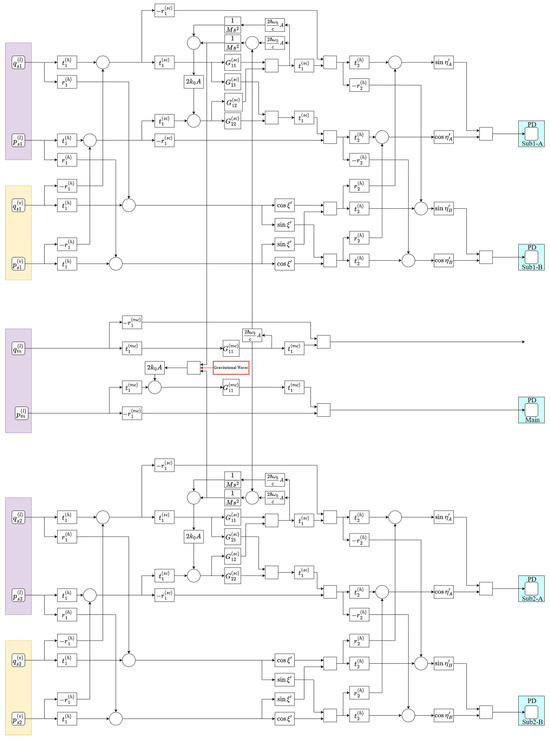
Figure 3.
Block diagram of the detection system incorporating optical-spring quantum locking and accounting for the effects of vacuum fluctuations. The upper and lower sections are the subcavities, and the central section is the main cavity. Purple areas represent quantum fluctuations of the laser light, yellow areas represent vacuum fluctuations mixed in during homodyne detection and cyan areas represent detection ports.
The amplitude transmittance and amplitude reflectance of a mirror are defined using the identifier , such as (sc), representing the subcavity, and the identifier n, representing 1 or 2, as follows:
Note that this equation assumes no loss effects for all mirrors. In addition, all mirrors used in each cavity have the same mass. In the diagram, the mirrors of the main cavity, which are shared with the subcavities, are depicted as blocks located in the upper or lower parts of the subcavities. In addition, denotes the matrix of optical-spring effects, which is determined by the detuning angle and sideband frequency , and can be expressed as
where c is the speed of light taken as , and L is the cavity length. Next, represents the angle between the phase direction of transmitted or reflected light by BS2 in and the axis determined by Equation (8), and it is defined as follows:
where denotes the angular orientation of each carrier light with respect to the phase direction of . The influence of gravitational waves is introduced into the system within the region enclosed by the red line positioned at the diagram’s center. This region corresponds to the displacement of the shared mirror induced by gravitational waves. It is worth noting that the impact of gravitational waves on the subcavities is not taken into consideration, given their relatively abbreviated cavity lengths, resulting in negligible alterations in the optical path length caused by gravitational waves. Hence, gravitational waves are detected in the phase direction by the photodetector situated at the central portion of the diagram, which captures the main laser light.
Likewise, by utilizing this block diagram, we can ascertain the amplification or attenuation of individual quantum fluctuations and their subsequent detection as noise. Table 1 showcases the transfer functions of this system, elucidating the correlation between mirror displacement caused by gravitational waves or each quantum fluctuation and the signals obtained by the five photodetectors. Within this table, the gravitational-wave signal is denoted by x, while p and q, as defined in the preceding subsection, represent the bases of the quantum fluctuations. By employing these bases and transfer functions, , the signal acquired from the photodetector for the main laser light, can be expressed as follows:

Table 1.
Transfer functions from the effects of gravitational waves or quantum fluctuations to each photodetector.
In the same way, , which are the signals obtained from the other four photodetectors, are defined by the combinations shown in the table. Here, note that these signals contain some common noise components, as the subcavities on both sides are assumed to have the same configuration.
3.2. Completing the Square
Completing the square in quantum locking is a signal optimization method that has shown high effectiveness in previous research for reducing quantum noise [18]. In this approach, a new signal is defined from the two signals and , with the combination coefficient chosen to minimize the power spectrum. To effectively utilize the signals from homodyne detection at two ports, we introduce additional combination coefficients and devise a method to optimize the combination of three signals. Thus, by using , and , along with the combination coefficients and , a new signal V is defined as follows:
The power spectrum of this signal is given by
Therefore, the values of and that minimize its power spectrum are determined as follows:
Finally, we utilize the three signals as follows:
where a is a transfer function from the displacement of the shared mirror caused by gravitational waves to the main photodetector, as shown in Table 1. Each signal is divided by a to calibrate it with the gravitational-wave signal.
4. Simulations
In this section, we delineate the parameter conditions employed in the simulation, as well as the method utilized for evaluating the sensitivity of the DECIGO. Table 2 exhibits the symbols and ranges/values employed in the simulation. The upper segment of this table presents the five variable parameters employed for optimizing sensitivity: and represent the amplitude transmittance of each beam splitter. The detuning angle reflects the effect of the optical spring, and finesse corresponds to the effective number of light reflections within the cavity. Additionally, is a parameter introduced to modulate the length of the optical path taken by the local oscillator. Since the two photodetectors are symmetrically positioned, the A and B signals can be interchanged by swapping the amplitude transmittance and reflectance values of BS2 and adjusting the parameter to become . Note that the range of is therefore defined as between 0 and . The eight parameters presented in the lower part of the table remain constant, with the exception of the cavity length, which differs between the main cavity and the subcavities.

Table 2.
Conditions of main parameters for the optimization of the DECIGO’s sensitivity.
Next, we adopt Signal-to-Noise Ratio (SNR) as a measure to evaluate the sensitivity of the DECIGO to primordial gravitational waves. The SNR is given by [24]:
where and represent spectral densities of noise, as computed following the methodology outlined in Section 3. Notably, in this case, and assume equal values. The remaining parameters employed in the SNR computation are presented in Table 3. In Equation (19), T signifies the observation period, which was set to a duration of 3 years. denotes the energy density of primordial gravitational waves, and for the purpose of this research, a fixed value of was adopted. Furthermore, denotes the overlap reduction function [24], assumed to be unity in the configuration of the DECIGO. Additionally, the SNR assessment specifically concentrates on the frequency band spanning from Hz to 1 Hz, wherein the DECIGO is expected to exhibit high sensitivity to gravitational waves.

Table 3.
Parameters used to calculate the SNR [21].
5. Result and Discussion
Based on the simulation results, we obtained the optimized sensitivity curves of the DECIGO with optical-spring quantum locking to detect primordial gravitational waves, as shown in Figure 4. Each sensitivity curve, excluding the shot noise caused by phase quantum fluctuations of the main laser light, exhibits a dip around 0.1 Hz, and these dips align with each other. On the other hand, the shot noise, which has no dip, remains nearly constant within the target frequency band and contributes to the baseline of the DECIGO’s sensitivity. Furthermore, Table 4 shows the parameters that minimize noise in relation to the gravitational-wave signal, resulting in a calculated SNR of 79.6. The more refined model presented in this paper gives a different result from less-detailed modeling (SNR = 141), as shown in Figure 5. Here, note that this differs from the results (SNR = 214) described in the previous paper [21]. The previous paper used approximations; a constant amplitude of the light was assumed even in the case of an off-resonant condition. In this paper, we calculated the SNR without any approximations and obtained an SNR of 141.In this paper, the local oscillator is extracted from the incoming light directed towards the cavity. As a result, the laser light going to the subcavities is smaller, and the noises are relatively higher due to the effects entering from the vacuum fluctuation. In addition, the local light must have a large value in order to obtain an arbitrary homodyne angle. In the previous research, we considered a hypothetical situation in which the local laser power is infinite, independent of the incoming light directed towards the cavity. However, since it is not possible to do so in reality, we obtained degraded but realistic sensitivity. In contrast, the SNR without optical-spring quantum locking is 1.74, indicating that optical-spring quantum locking significantly helps reduce quantum noise, even when the effect of vacuum fluctuations is considered.
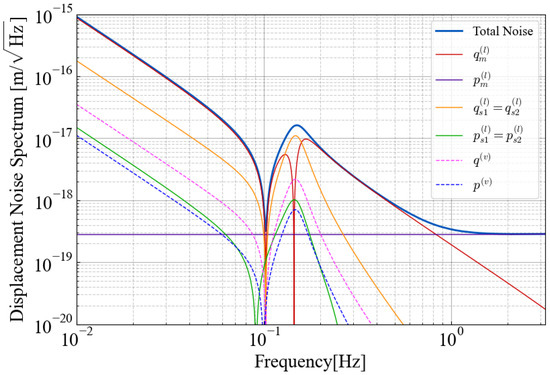
Figure 4.
Optimized sensitivity curves with contributions from noise sources: The total noise is represented by the thick blue line, while each quantum noise caused by fluctuations of the laser light or vacuum fluctuations is shown as thin lines. Especially, quantum noises originating from vacuum fluctuations are depicted as dashed lines. Additionally, the green or yellow lines represent signals obtained only from subcavity 1. Therefore, note that when adding the signal from subcavity 2 to this figure, the curve will be scaled up by a factor of .

Table 4.
Optimized parameters.
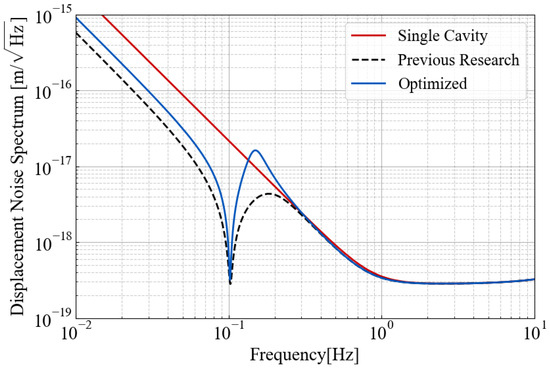
Figure 5.
Optimized sensitivity curves considering noise contributions: The blue line represents the sensitivity curve optimized in this study, which corresponds to the total noise in Figure 4. The dashed line represents the sensitivity curve optimized in the previous research [21], resulting in an SNR of 141. The red line represents the optimized sensitivity curve when using a single cavity with a length of 1000 km.
6. Conclusions
To assess the efficacy of homodyne detection in subcavities with optical-spring quantum locking for mitigating noise in the DECIGO, it was imperative to consider a detector configuration that accounts for vacuum fluctuations. In this paper, we investigated the determination of the homodyne angle by employing extracted light, serving as a local oscillator, and subsequently constructed a comprehensive block diagram incorporating vacuum fluctuations. Moreover, this particular configuration enables the utilization of two photodetectors, which sets it apart from previous DECIGO configurations that allowed only the use of a single photodetector. We presented an optimization method for processing the signals acquired from each photodetector to obtain the optimized sensitivity curve. By optimizing the parameters with these configurations, the impact of vacuum fluctuations was evaluated. Although the effect of vacuum fluctuation results in a sensitivity slightly inferior to that of the ideal situation shown in previous research, it still exhibits a marked improvement compared with the scenario without optical-spring quantum locking. Consequently, we demonstrate that homodyne detection in optical-spring quantum locking is an effective technique for noise reduction in the DECIGO, with the potential to significantly contribute to the observation of primordial gravitational waves.
Author Contributions
Conceptualization, K.T., T.I. and S.K.; methodology, T.I. and K.K.; software, K.T.; validation, S.K., K.N., Y.E. and K.K.; formal analysis, K.K. and K.N.; investigation, K.T.; resources, S.K.; data curation, S.K.; writing—original draft preparation, K.T.; writing—review and editing, all; visualization, K.T. and S.K.; supervision, S.K.; project administration, S.K.; funding acquisition, S.K. All authors have read and agreed to the published version of the manuscript.
Funding
This work was supported by JSPS KAKENHI, Grants No. JP19H01924 and No. JP22H01247. This work was also supported by Murata Science Foundation.
Data Availability Statement
There is no experimental data for paper.
Acknowledgments
We would like to thank David H. Shoemaker for commenting on a draft.
Conflicts of Interest
Author Dr. Koji Nagano was employed by the company LQUOM, Inc., and author Dr. Yutaro Enomoto is employed by the company Fujitsu Limited. The remaining authors declare that the research was conducted in the absence of any commercial or financial relationships that could be construed as a potential conflict of interest.
References
- Abbott, B.P.; et al.; [LIGO Scientific Collaboration and Virgo Collaboration] Observation of Gravitational Waves from a Binary Black Hole Merger. Phys. Rev. Lett. 2016, 116, 061102. [Google Scholar] [CrossRef] [PubMed]
- Abbott, R.; et al.; [LIGO Scientific Collaboration and Virgo Collaboration] GWTC-2: Compact Binary Coalescences Observed by LIGO and Virgo during the First Half of the Third Observing Run. Phys. Rev. X 2021, 11, 021053. [Google Scholar] [CrossRef]
- Punturo, M.; Abernathy, M.; Acernese, F.; Allen, B.; Andersson, N.; Arun, K.; Barone, F.; Barr, B.; Barsuglia, M.; Beker, M.; et al. The third generation of gravitational wave observatories and their science reach. Class. Quant. Grav. 2010, 27, 084007. [Google Scholar] [CrossRef]
- Dwyer, S.; Sigg, D.; Ballmer, S.W.; Barsotti, L.; Mavalvala, N.; Evans, M. Gravitational wave detector with cosmological reach. Phys. Rev. D 2015, 91, 082001. [Google Scholar] [CrossRef]
- Amaro-Seoane, P.; Audley, H.; Babak, S.; Baker, J.; Barausse, E.; Bender, P.; Berti, E.; Binetruy, P.; Born, M.; Bortoluzzi, D.; et al. Laser Interferometer Space Antenna. arXiv 2017, arXiv:1702.00786. [Google Scholar]
- Kuroyanagi, S.; Tsujikawa, S.; Chiba, T.; Sugiyama, N. Implications of the B-mode polarization measurement for direct detection of inflationary gravitational waves. Phys. Rev. D 2014, 90, 063513. [Google Scholar] [CrossRef]
- Aasi, J.; et al.; [LIGO Scientific Collaboration] Advanced LIGO. Class. Quant. Grav. 2015, 32, 074001. [Google Scholar]
- Acernese, F.; Agathos, M.; Agatsuma, K.; Aisa, D.; Allemandou, N.; Allocca, A.; Amarni, J.; Astone, P.; Balestri, G.; Ballardin, G.; et al. Advanced Virgo: A second-generation interferometric gravitational wave detector. Class. Quant. Grav. 2014, 32, 024001. [Google Scholar] [CrossRef]
- Somiya, K. Detector configuration of KAGRA–the Japanese cryogenic gravitational-wave detector. Class. Quant. Grav. 2012, 29, 0124007. [Google Scholar] [CrossRef]
- Seto, N.; Kawamura, S.; Nakamura, T. Possibility of Direct Measurement of the Acceleration of the Universe Using 0.1 Hz Band Laser Interferometer Gravitational Wave Antenna in Space. Phys. Rev. Lett. 2001, 87, 221103. [Google Scholar] [CrossRef]
- Kawamura, S.; Ando, M.; Seto, N.; Sato, S.; Musha, M.; Kawano, I.; Yokoyama, J.; Tanaka, T.; Ioka, K.; Akutsu, T.; et al. Current status of space gravitational wave antenna DECIGO and B-DECIGO. Prog. Theor. Exp. Phys. 2021, 2021, 05A105. [Google Scholar] [CrossRef]
- Akrami Cheghasiahi, Y.; Arroja, F.; Ashdown, M.; Aumont, J.; Baccigalupi, C.; Ballardini, M.; Banday, A.J.; Barreiro, R.; Bartolo, N.; Basak, S.; et al. Planck 2018 results: X. Constraints on inflation. Astron. Astrophys. 2020, 641, A10. [Google Scholar]
- Iwaguchi, S.; Ishikawa, T.; Ando, M.; Michimura, Y.; Komori, K.; Nagano, K.; Akutsu, T.; Musha, M.; Yamada, R.; Watanabe, I.; et al. Quantum Noise in a Fabry-Perot Interferometer Including the Influence of Diffraction Loss of Light. Galaxies 2021, 9, 9. [Google Scholar] [CrossRef]
- Ishikawa, T.; Iwaguchi, S.; Michimura, Y.; Ando, M.; Yamada, R.; Watanabe, I.; Nagano, K.; Akutsu, T.; Komori, K.; Musha, M.; et al. Improvement of the Target Sensitivity in DECIGO by Optimizing Its Parameters for Quantum Noise Including the Effect of Diffraction Loss. Galaxies 2021, 9, 14. [Google Scholar] [CrossRef]
- Kawasaki, Y.; Shimizu, R.; Ishikawa, T.; Nagano, K.; Iwaguchi, S.; Watanabe, I.; Wu, B.; Yokoyama, S.; Kawamura, S. Optimization of Design Parameters for Gravitational Wave Detector DECIGO Including Fundamental Noises. Galaxies 2022, 10, 25. [Google Scholar] [CrossRef]
- Courty, J.-M.; Heidmann, A.; Pinard, M. Quantum Locking of Mirrors in Interferometers. Phys. Rev. Lett. 2003, 90, 083601. [Google Scholar] [CrossRef]
- Heidmann, A.; Courty, J.-M.; Pinard, M.; Lebars, J. Beating quantum limits in interferometers with quantum locking of mirrors. Phys. Rev. Lett. 2004, 6, 5684. [Google Scholar] [CrossRef][Green Version]
- Yamada, R.; Enomoto, Y.; Nishizawa, A.; Nagano, K.; Kuroyanagi, S.; Kokeyama, K.; Komori, K.; Michimura, Y.; Naito, T.; Watanabe, I.; et al. Optimization of quantum noise by completing the square of multiple interferometer outputs in quantum locking for gravitational wave detectors. Phys. Lett. A 2020, 384, 126626. [Google Scholar] [CrossRef]
- Ishikawa, T.; Kawasaki, Y.; Tsuji, K.; Yamada, R.; Watanabe, I.; Wu, B.; Iwaguchi, S.; Shimizu, R.; Umemura, K.; Nagano, K.; et al. First-step experiment for sensitivity improvement of DECIGO: Sensitivity optimization for simulated quantum noise by completing the square. Phys. Rev. D 2023, 107, 022007. [Google Scholar] [CrossRef]
- Braginskiǐ, V.B.; Manukin, A.B.; Tikhonov, M.Y. Investigation of dissipative ponderomotive effects of electromagnetic radiation. Sov. J. Exp. Theor. Phys. 1970, 31, 829. [Google Scholar]
- Yamada, R.; Enomoto, Y.; Watanabe, I.; Nagano, K.; Michimura, Y.; Nishizawa, A.; Komori, K.; Naito, T.; Morimoto, T.; Iwaguchi, S.; et al. Reduction of quantum noise using the quantum locking with an optical spring for gravitational wave detectors. Phys. Lett. A 2021, 402, 127365. [Google Scholar] [CrossRef]
- Schleich, W.P. Quantum Optics in Phase Space; John Wiley & Sons: Hoboken, NJ, USA, 2011. [Google Scholar]
- Caves, C.M. Quantum-mechanical noise in an interferometer. Phys. Rev. D 1981, 23, 1693. [Google Scholar] [CrossRef]
- Allen, B.; Romano, J.D. Detecting a stochastic background of gravitational radiation: Signal processing strategies and sensitivities. Phys. Rev. D 1999, 59, 102001. [Google Scholar] [CrossRef]
Disclaimer/Publisher’s Note: The statements, opinions and data contained in all publications are solely those of the individual author(s) and contributor(s) and not of MDPI and/or the editor(s). MDPI and/or the editor(s) disclaim responsibility for any injury to people or property resulting from any ideas, methods, instructions or products referred to in the content. |
© 2023 by the authors. Licensee MDPI, Basel, Switzerland. This article is an open access article distributed under the terms and conditions of the Creative Commons Attribution (CC BY) license (https://creativecommons.org/licenses/by/4.0/).